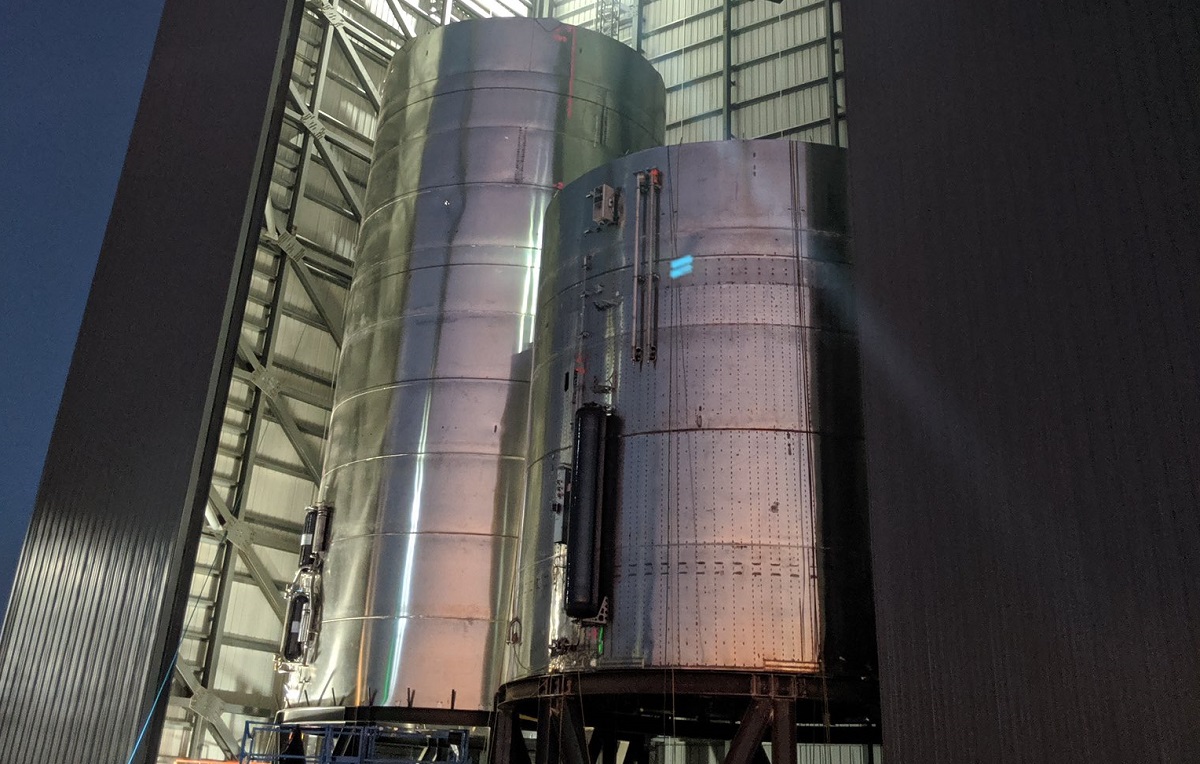For almost a year now, SpaceX has been building a series of Starship prototypes that will test how the system fares when launched to orbit. Coming on the heels of successful hop tests with the Starship Hopper, these tests will validate the spacecraft and its Raptor engines in space. Unfortunately, the company has encountered some hiccups with these prototypes, where the first two exploded during pressure testing.
The first prototype, Starship Mk.1, exploded on the launchpad on November 20th, 2019, during a cryogenic loading test that sent its nose cone flying. The second prototype, SN1, also exploded during a pressure test on the evening of Feb. 28th, 2020, causing the fuselage to jump several meters in the air before hitting the ground and exploding again. Undeterred, Musk recently shared images of the components for the SN3 prototype undergoing assembly.
Shortly after these images were shared, the assembled components were seen on their way to the company’s test facility at Boca Chica, Texas, on the morning of March 29th. They were then seen being transferred to the launch pad by roll-lift and crane as of late afternoon. Footage of both these events was captured by the LabPadre and shared via Twitter.
Like its predecessors, the next step for the SN3 will be cryogenic loading trials, where the spacecraft’s methane and oxygen tanks will be filled with a cryogenic liquid (most likely liquid nitrogen). During this test, the first prototype experienced a failure that caused its top bulkhead to suffer a blowout that sent the nose cone flying. The bottom bulkhead then blew out, sending cryogenic vapor all across the landing pad.
The second prototype experienced a similar failure, with a blowout taking place near the bottom that sent the upper section into the air and the fuselage to implode. The top section then landed on its side and experienced a second explosion, this time from the top. Hopefully, the SN3 will fare better, which Musk hopes to use to conduct short test flights to Earth’s atmosphere.
In a previous statement, Musk announced that the SN3 would be used for static fire tests and short flights, whereas longer test flights will wait upon the SN4. As Musk indicated, the priority right now is on the production of additional Starship test vehicles and Raptor engines. There is also documentation that indicates that SpaceX will be conducting tests as early as next week.
The documents, which were shared on NASASpaceFlight, reference a permit issued by the Federal Aviation Administration (FAA) for the “Starhopper” vehicle (which is valid until June 2020). They further suggest that a static fire of the SN3’s engines could take place between April 1st and 3rd, followed by a 150-meter (500 ft) hop test between April 6th and 8th. This was the maximum height achieved by the Starship Hopper.
It remains unclear if these recent setbacks will alter Musk’s long term plans. Once the Starship is finished and integrated with the Super Heavy booster, Musk hopes to begin conducting payload runs to the Moon by 2022, followed by crewed missions to the surface by 2024. In between, Musk also intends to conduct the first lunar tourism mission (#dearmoon), which will involve sending a crew of artists around the Moon in 2023.
Meanwhile, SpaceX continues to deploy batches of satellites as part of its Starlink constellation and will be delivering commercial payloads to the ISS and the Moon. These will be made as part of it’s Commercial Crew Development (CCD) and Cargo Transportation and Landing by Soft Touchdown (CATALYST) contracts with NASA, respectively.
Best of luck to you SN3! We look forward to seeing you make that hop test and returning safely to Earth. If all goes well, we look forward to seeing SN4 reach orbit too!


“During this test, the first prototype experienced a failure that caused its top bulkhead to suffer a blowout that sent the nose cone flying. The bottom bulkhead then blew out, sending cryogenic vapor all across the landing pad.
The second prototype experienced a similar failure, with a blowout taking place near the bottom that sent the upper section into the air and the fuselage to implode.”
The MK1 prototype was a gamble, and a bulkhead weld blew. So in between that and SN1 they made two test tanks where they showed in destructive tests that the bulkheads and new welding method sufficed.
Unfortunately they didn’t test the thrust assembly that blew on SN1. So thrust assembly development and test was what SN2 was converted into.
This takes us to SN3, and SpaceX is mildly optimistic this time around too – the prototype has legs so can eventually do hop tests.
I *think* Starship development is laser focused on Starlink launching, since a) it makes economic sense from the get go with minimal Starship/SuperHeavy development and b) it seems the prototypes have had at least one header tank pushed to the nose for a quick fix of center-of-gravity balancing.